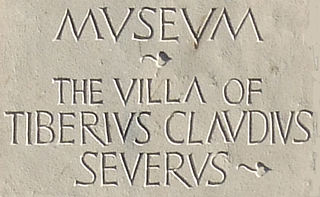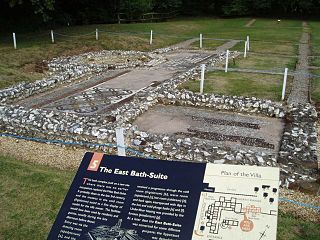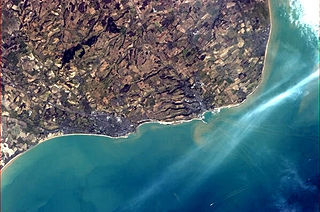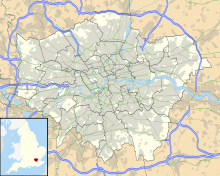
Jarlshof is the best known prehistoric archaeological site in Shetland, Scotland. It lies in Sumburgh, Mainland, Shetland and has been described as "one of the most remarkable archaeological sites ever excavated in the British Isles". It contains remains dating from 2500 BC up to the 17th century AD.

The Medway Megaliths, sometimes termed the Kentish Megaliths, are a group of Early Neolithic chambered long barrows and other megalithic monuments located in the lower valley of the River Medway in Kent, South-East England. Constructed from local sarsen stone and soil between the 4th and 3rd millennia BCE, they represent the only known prehistoric megalithic group in eastern England and the most south-easterly group in Britain.

Crofton Roman Villa in Crofton, Orpington, in the London Borough of Bromley, is a Roman villa which was inhabited between approximately 140 and 400 AD. It was the centre of a farming estate of about 500 acres (200 ha), with farm buildings nearby, surrounded by fields, meadows and woods. The house was altered several times during its 260 years of occupation, and at its largest it probably had at least 20 rooms.

Piddington Roman Villa is the remains of a large Roman villa at Piddington, Northamptonshire, about 6 miles (9.7 km) south-east of Northampton, a county in the East Midlands of England.

Rockbourne Roman Villa is a Roman courtyard villa excavated and put on public display in the village of Rockbourne in the English county of Hampshire. The villa was discovered in 1942 by a local farmer and excavated by A. T. Morley Hewitt over the next thirty years.

Regulbium was the name of an ancient Roman fort of the Saxon Shore in the vicinity of the modern English resort of Reculver in Kent. Its name derives from the local Brythonic language, meaning "great headland" (*Rogulbion).

The history of Folkestone stretches back to prehistoric times, with evidence of human habitation dating to the Mesolithic and Paleolithic ages over 12,000 years ago. Its close proximity to the Continent means that it has often been a point of transit for migrating people groups. The area has alternatively been occupied by groups of Britons, Romans and Saxons. During the Iron Age, a large oppidum and quern-stone workshop were situated on the eastern headlands of the bay. By the Roman era, it had been transformed into a large Roman Villa overlooking the sea.

Moel y Gaer is an Iron Age hillfort located on a summit at the southern end of Halkyn Mountain, overlooking the village of Rhosesmor, Flintshire, Wales. It is a well-preserved hillfort overlooking the Dee Estuary. Excavations in the early 1970s revealed a sequence of defensive structures made of timber and several phases of building work inside the ramparts.

Buckland Rings is the site of an Iron Age hill fort in the town of Lymington, Hampshire. Today, the mounds and dykes around the outside which once constituted its defences are still clearly visible, although the outer bank lies under the road on the west side, and on the south-east it is nearly ploughed-out. Excavations of the inner and middle ramparts in 1935 revealed that they were of wall-and-fill construction, retained at the front by upright timber beams and walls of cut and laid turf. The entrance, which lies on the east side, was also excavated revealing a long entrance passage and the postholes for a pair of stout gateposts. The site was bought by Hampshire County Council in 1989 to ensure its preservation, and it is open to the public from the A337 road onto which part of it faces.

Blewburton Hill is the site of an Iron Age hillfort located in Oxfordshire, in the southeast of England. It was a univallate hillfort. The area is mostly farmland with some small areas of wooded copse to the south and the northeast. The hill fort may have been occupied from the 4th century BC to the 1st century BC, and replaced a small settlement surrounded by a stockade, which is estimated to have been built in the 5th or 6th century BC.

Bancroft Roman Villa is a Roman villa in the Bancroft district of Milton Keynes in Buckinghamshire, England. Originally a winged-corridor house, the villa eventually became a grand building with mosaics and a formal garden. The principal rooms have been marked out in Bancroft Park and the fish-pond has been reconstructed. One of the mosaics is on display in Central Milton Keynes Shopping Centre.

Polhill Anglo-Saxon cemetery is a place of burial that was used in the seventh and eighth centuries CE. It is located close to the hamlet of Polhill, near Sevenoaks in Kent, South-East England. Belonging to the Middle Anglo-Saxon period, it was part of the much wider tradition of burial in Early Anglo-Saxon England.

The Żejtun Roman villa is an archaeological complex in the city of Żejtun, in south-eastern Malta. The open-air remains contain areas of original Roman tiling and coloured stucco. The complex was an active settlement since the Bronze Age, although the presently visible remains can be mainly dated from the Punic period right up to Late Antiquity. The site was discovered in 1961, with the complex being the subject of two large-scale archaeological investigations, the first of which was carried out in the 1970s.

Folkestone Roman Villa, also referred to as the East Bay Site, is a villa built during the Roman Occupation of Britain, and is located in East Wear Bay near the port town of Folkestone, in Kent, England. The villa is situated on a cliff top overlooking the English Channel, with views of the French coast at Boulogne on a clear day. It is situated near the start of the North Downs Trackway, and the area has been inhabited for thousands of years, with archeological finds in the area and at the villa site dating back to the mesolithic and neolithic ages. The villa was built around A. D. 75, and was almost certainly built within the confines of a preexisting Iron Age settlement.

Tønnesminde is the site of an archaeological excavation ground and present day organic farm on the island of Samsø, Denmark. Archaeological evidence attests the area around Tønnesminde has a long history of human occupation, dating from approximately 4000 BC to present day. Recent excavations suggest that Tønnesminde contains settlements dating from the Funnelbeaker culture in the Early Neolithic period, Early Bronze Age, Pre-Roman Iron Age, and Viking Age.

Archaeology is promoted in Jersey by the Société Jersiaise and by Jersey Heritage. Promotion in the Bailiwick of Guernsey being undertaken by La Société Guernesiaise, Guernsey Museums, the Alderney Society with World War II work also undertaken by Festung Guernsey.

Tel Yokneam, also spelled Yoqne'am or Jokneam, is an archaeological site located between the modern city of Yokneam Illit and the town of Yokneam Moshava. It was known in Arabic by a variant name, Tell Qamun, believed to be a corruption of the Hebrew name. The site is an elevated mound, or tel, spanning around 40 dunams and rising steeply to a height of 60 meters (200 ft). With a few brief interruptions, Yokneam was occupied for 4,000 years, from the Middle Bronze Age to the Ottoman Empire.

Endebjerg is the location of an excavation site set in the middle of farmland on the island of Samsø, Denmark. A series of excavations have shown that this site has been occupied by a variety of cultures since the Early Neolithic period. The site was first officially excavated in 1988 under Christian Adamsen. It was most recently excavated in the summer of 2018 by a joint task force of the Harvard University Viking Studies Program and Moesgaard Museum, led by Peter Jensen.

Tel Qiri is a tel and an ancient village site located inside the modern kibbutz of HaZore'a in northern Israel. It lies on the eastern slopes of the Menashe Heights and the western edge of the Jezreel Valley. As of the beginning of the excavations in 1975, almost half of the site was still visible, but today the entire site is covered by the houses of HaZore'a. The site spans an area of one hectare and is believed to have been a dependency of the nearby Tel Yokneam. The site hosted some human activity during the Neolithic and Chalcolithic periods, as well as parts of the Bronze Age. An uninterrupted sequence of settlement lasted from the Iron Age to the Roman-Byzantine period. Unlike all urban centers in northern Israel, the village in Tel Qiri, which flourished during the Iron Age, escaped all military events and no traces of destruction can be found there. This minor, damaged and seemingly insignificant site yielded an amazingly rich and diverse quantity of remains of different periods.
Tel Mevorakh is a small mound situated on the southern bank of Nahal Taninim in Israel. The tel does not exceed 1 dunam but rises to a height of 15 metres (50 ft) above its surrounding plain. The site contains some fifteen layers of human settlement, which accumulate to a height of 8 meters, meaning the natural hill does not exceed a height of 7 meters. It is located on the border between the wide Sharon Plain and the coast of Mount Carmel.


























